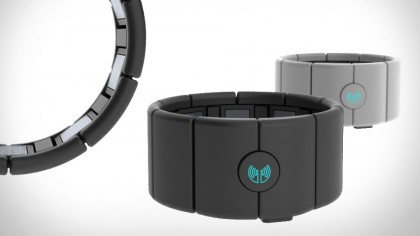Looking beyond Google Glass: the future of wearable tech
We talk to some of the major players involved in the most exciting new sector in tech
While some of these wearable devices will undoubtedly be controlled by our voices, pioneered of course by Google Glass, bodily gestures will certainly represent another key input method for devices on our purpose. One company representing that element is Thalmic Labs in Waterloo, Ontario, Canada - home of BlackBerry.
The Myo wristband, which is currently available to pre-order (25,000 people already have, for $149), responds to the electrical activity in the muscles, enabling users to control secondary devices like smartphones, PCs or games consoles through gestures.
Co-founder and CEO Stephen Lake told us: "We believe that as we move forward we believe that coupling between humans and technology is going to become tighter and tighter, the line between the two will continue to be blurred. The exciting part for us is that we'll be able to use the technology to enhance our abilities and enhance our every day lives in various ways.
"The Myo is a missing link right now. It's a wearable human computer interface, connecting the real and the digital world. In our experience voice is that it's not really a viable input mechanism. There are certain limited cases where it works really well, but it's really challenging to be that crazy guy on the subway, talking to yourself with your funny glasses on. We're really excited about how better interface methods can improve the experience."

The benefits are clearest in the work and gaming space. Controlling presentations sans a tethered clicker, or playing first person shooters with the lightweight Myo communicating your physical pull of the trigger back to the console. Healthcare and the creative industries are a big possibility too, Edwards said.
"We have a long tail of developers that have ideas all over the place. Someone has been talking to us about using this for image-guided surgery, while others are interested in creating musical content, 3D modelling or manipulations, there are thousands of different ideas. A big part of what we've been doing is trying to enable those developers to come to us with those applications and really get some more insight into which ones of those thousands of ideas arte going to be the salient ones."
Eventually, according to Frog Design's Brandon Edwards, wearable tech might see a devolution of the smartphone into dedicated devices, carried on our person, stitched within our clothes, hugging our skin, performing dedicated tasks, creating the fabled bionic man.
Get daily insight, inspiration and deals in your inbox
Sign up for breaking news, reviews, opinion, top tech deals, and more.
"Personally, I compare the iPhone to a Swiss army knife," he said. "There was a time when everyone carried one, but those days have gone away. The smartphone works and it's not going to go away when these single purpose, single task objects come about, but they'll be much more intuitive and much more in tune with what someone wants to do with them.
"I get very excited about seeing the miniaturisation of so many different sorts of tasks and pulling them out of that Swiss army knife into discreet areas where they could be very, very helpful. We've only just started to scratch the surface."
Are you ready to become Human 2.0?
A technology journalist, writer and videographer of many magazines and websites including T3, Gadget Magazine and TechRadar.com. He specializes in applications for smartphones, tablets and handheld devices, with bylines also at The Guardian, WIRED, Trusted Reviews and Wareable. Chris is also the podcast host for The Liverpool Way. As well as tech and football, Chris is a pop-punk fan and enjoys the art of wrasslin'.
